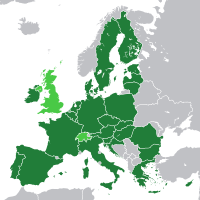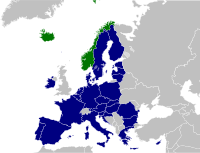Wikipedia:WikiProject European Union/Templates: Difference between revisions
→Banner: copyedit |
|||
| Line 46: | Line 46: | ||
<br style="clear: both"> |
<br style="clear: both"> |
||
==== |
====Structural evolvement==== |
||
* {{tl|EU |
* {{tl|EU evolvement timeline}}} |
||
{{EU-timeline}} |
{{EU-timeline}} |
||
<br style="clear: both"> |
|||
====Treaties and declarations==== |
|||
* {{tl|EU treaties and declarations}} |
|||
{{EU treaties and declarations}} |
|||
<br style="clear: both"> |
<br style="clear: both"> |
||
Revision as of 15:48, 27 March 2008
Below are a collection of all templates relating to the WikiProject.
Banner
This template is to be placed on the talk page of any article relating to the European Union:
The WikiProject banner below should be moved to this page's talk page. If this is a demonstration of the template, please set the parameter |category=no to prevent this page being miscategorised. |
| European Union NA‑class | |||||||
| |||||||
Article templates
These are some current templates relating to certain articles about the European Union:
General
Template:European Union-related topics
Political
Politics
| This article is part of a series on |
 |
|---|
|
|
Foreign relations
Defence
- {{EDA}}
Political parties and groups
- {{EU politics}}
Directorates General
Agencies
Structural evolvement
Since the end of World War II, sovereign European countries have entered into treaties and thereby co-operated and harmonised policies (or pooled sovereignty) in an increasing number of areas, in the European integration project or the construction of Europe (French: la construction européenne). The following timeline outlines the legal inception of the European Union (EU)—the principal framework for this unification. The EU inherited many of its present responsibilities from the European Communities (EC), which were founded in the 1950s in the spirit of the Schuman Declaration.
| Legend: S: signing F: entry into force T: termination E: expiry de facto supersession Rel. w/ EC/EU framework: de facto inside outside |
[Cont.] | |||||||||||||||||
| (Pillar I) | ||||||||||||||||||
| European Atomic Energy Community (EAEC or Euratom) | [Cont.] | |||||||||||||||||
| European Economic Community (EEC) | ||||||||||||||||||
| Schengen Rules | European Community (EC) | |||||||||||||||||
| 'TREVI' | Justice and Home Affairs (JHA, pillar II) | |||||||||||||||||
| [Cont.] | Police and Judicial Co-operation in Criminal Matters (PJCC, pillar II) | |||||||||||||||||
Anglo-French alliance |
[Defence arm handed to NATO] | European Political Co-operation (EPC) | Common Foreign and Security Policy (CFSP, pillar III) | |||||||||||||||
| [Tasks defined following the WEU's 1984 reactivation handed to the EU] | ||||||||||||||||||
| [Social, cultural tasks handed to CoE] | [Cont.] | |||||||||||||||||
Entente Cordiale
S: 8 April 1904 |
Davignon report
S: 27 October 1970 |
European Council conclusions
S: 2 December 1975 |
||||||||||||||||
- ^ a b c d e Although not EU treaties per se, these treaties affected the development of the EU defence arm, a main part of the CFSP. The Franco-British alliance established by the Dunkirk Treaty was de facto superseded by WU. The CFSP pillar was bolstered by some of the security structures that had been established within the remit of the 1955 Modified Brussels Treaty (MBT). The Brussels Treaty was terminated in 2011, consequently dissolving the WEU, as the mutual defence clause that the Lisbon Treaty provided for EU was considered to render the WEU superfluous. The EU thus de facto superseded the WEU.
- ^ Plans to establish a European Political Community (EPC) were shelved following the French failure to ratify the Treaty establishing the European Defence Community (EDC). The EPC would have combined the ECSC and the EDC.
- ^ The European Communities obtained common institutions and a shared legal personality (i.e. ability to e.g. sign treaties in their own right).
- ^ The treaties of Maastricht and Rome form the EU's legal basis, and are also referred to as the Treaty on European Union (TEU) and the Treaty on the Functioning of the European Union (TFEU), respectively. They are amended by secondary treaties.
- ^ Between the EU's founding in 1993 and consolidation in 2009, the union consisted of three pillars, the first of which were the European Communities. The other two pillars consisted of additional areas of cooperation that had been added to the EU's remit.
- ^ The consolidation meant that the EU inherited the European Communities' legal personality and that the pillar system was abolished, resulting in the EU framework as such covering all policy areas. Executive/legislative power in each area was instead determined by a distribution of competencies between EU institutions and member states. This distribution, as well as treaty provisions for policy areas in which unanimity is required and qualified majority voting is possible, reflects the depth of EU integration as well as the EU's partly supranational and partly intergovernmental nature.
Treaties and declarations
Non-political
Euro coins menu
- {{EU coins menu}}
Members and enlargment
- {{EU countries}}
Euro topics
- {{Euro topics}}
Stub templates
- {{EU-stub}} for stubs relating to the European Union
- {{MEP-stub}} for stubs relating to MEPs
- {{EU-org-bio-stub}} for stubs relating to Commissioners and other unelected EU posts
- Alternative Stub templates
- {{Euro-stub}} for finding mis-categorised EU-stubs
- {{poli-stub}} for finding mis-categorised EU-stubs
- {{int-org-stub}} for finding mis-categorised EU-stubs







